新概念第一册 第43课
新概念英语第一册-第43-44课课件(共34张PPT)
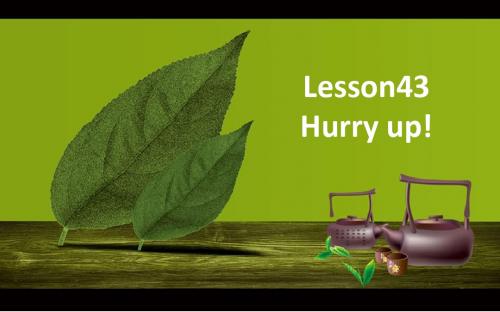
我们会说英语 We can speak English. 他会游泳吗? Can he swim? 我看不到你。 I can't see you. 我可以坐在哪里? Where can I sit?
There be 句型
• There are some/数量 +可复+介+sw. • Are there any +可复+介+sw.? • There aren't any +可复+介+sw. • There is some+不可数名词+介+sw. • Is there any 不可数名词+介+sw.? • There isn't any+不可数名词+介+sw.
Is he cooking a meal now?
• 他正在做饭吗? Is he cooking now?
强调的是结果
look for 寻找(强调寻找的过程,动作) • What are you doing? • I'm looking for my pen,but I can't find it.
a bar of chocolate
a pair of trousers
three slices of bread
three bottles of lemonade
New words & Expressions
make the tea 沏茶
tea 茶叶,茶树,茶水 ,茶点
teahouse 茶馆 teaegg 茶叶蛋
Corrections:( 每句有一个错误)
新概念一英语Lesson43 Hurry up(ppt课件)
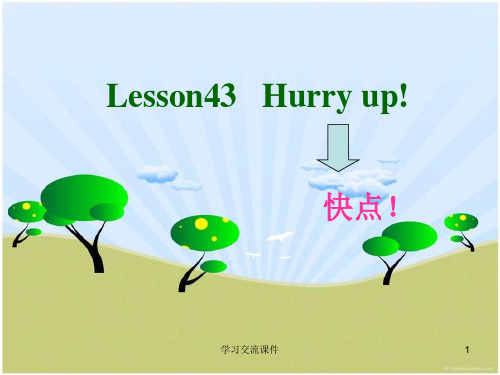
学习交流课件
16
疑问句句型分为:一般疑问句句型和特殊疑问句句型两 种类型。
1、一般疑问句句型为: Can+主语+动词原形+其它。 表示"某人会(能,可以)做……吗?"
你可以为我们大家唱一首英语歌吗?
Can you sing an English song for us?
是的,我可以。
Yes I can . No , I can't
奥,是啊。我现 Ah yes ,I can see it now !
在看到了
学习交流课件
8
Where are the cups? There are some in the cupboard. Can you find them? Yes. Here they are. Hurry up, Sam! The kettle's boiling!
我能游泳 I can swim 。
学习交流课件
15
2、否定句型: 主语+can not(can't/cannot)+动词原形+其它。
表示某人不会做.......不可能....
我不会骑摩托车。
I can't ride a motorbike .
韩梅不可能在教室里。 Han Mei can't be in the classroom.
• 例如:
• You can't play football in the street.不准在马路上踢足 球。
学习交流课件
12
• ③情态动词can的过去式could,用于现在时,可使语气更委 婉、更客气。
• 例如:
• Could you help me with my English? • 你能帮助我学习英语吗?
新概念一英语Lesson43 Hurry up
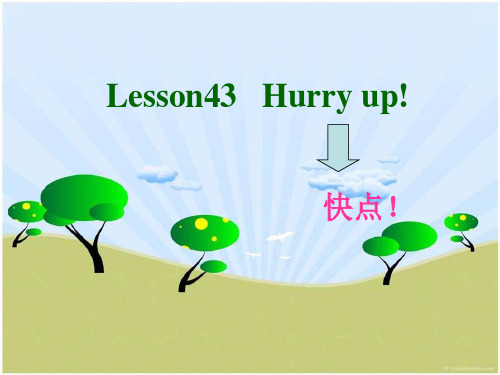
动词 名词
make see find hurry boil
tea water kettle teapot front cups cupboard
介词
of over behind in
语法精讲:情态动词can 的用法
情态动词can有一定的词义,但不能独立存在,它必须与动词原形 一起构成谓语。情态动词can没有人称和数的变化。其具体用法如 下:
Are there any…? Is there any…?
bread/ on the table Is there any bread here? Yes, there is. There's some on the table.
milk/ in front of the door water/ in those glasses soap/ on the cupboard tea/ in those cups
你可以为我们大家唱一首英语歌吗?
Can you sing an English song for us?
是的,我可以。
Yes I can . No , I can't
Lesson 44
名词单复数变化规则+口诀
一、可数名词都有单数和复数之分。 A: 规则的可数名词的复数变化规则: 1.一般情况加 s : book-- books mouth---mouths
球。
• ③情态动词can的过去式could,用于现在时,可使语气更委 婉、更客气。
• 例如:
• Could you help me with my English? • 你能帮助我学习英语吗?
概括 : 情态动词 can 的用法
• 1、表示能力,“能够” • 2、表示可能性,“可能” • 3、can的过去式 could 用于委婉语气。 • 4、表示“可以”
新概念一lesson43-48课文及知识点
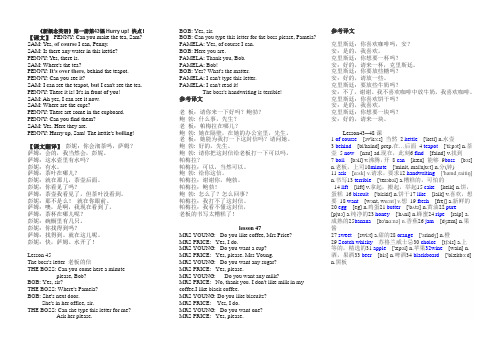
《新概念英语》第一册第43课Hurry up! 快点!【课文】PENNY: Can you make the tea, Sam? SAM: Yes, of course I can, Penny.SAM: Is there any water in this kettle? PENNY: Yes, there is.SAM: Where's the tea?PENNY: It's over there, behind the teapot. PENNY: Can you see it?SAM: I can see the teapot, but I can't see the tea. PENNY: There it is! It's in front of you!SAM: Ah yes, I can see it now.SAM: Where are the cups?PENNY: There are some in the cupboard. PENNY: Can you find them?SAM: Yes. Here they are.PENNY: Hurry up, Sam! The kettle's boil ing! 【课文翻译】彭妮:你会沏茶吗,萨姆?萨姆:会的,我当然会,彭妮。
萨姆:这水壶里有水吗?彭妮:有水。
萨姆:茶叶在哪儿?彭妮:就在那儿,茶壶后面。
彭妮:你看见了吗?萨姆:茶壶我看见了,但茶叶没看到。
彭妮:那不是么!就在你眼前。
萨姆:噢,是啊,我现在看到了。
萨姆:茶杯在哪儿呢?彭妮:碗橱里有几只。
彭妮:你找得到吗?萨姆:找得到。
就在这儿呢。
彭妮:快,萨姆。
水开了!Lesson 45The boss's letter 老板的信THE BOSS: Can you come here a minuteplease, Bob?BOB: Yes, sir?THE BOSS: Where's Pamela?BOB: She's next door.She's in her office, sir.THE BOSS: Can she type this letter for me?Ask her please. BOB: Yes, sir.BOB: Can you type this letter for the boss please, Pamela?PAMELA: Yes, of course I can.BOB: Here you are.PAMELA: Thank you, Bob.PAMELA: Bob!BOB: Yes? What's the matter.PAMELA: I can't type this letter.PAMELA: I can't read it!The boss's handwriting is terrible!参考译文老板:请你来一下好吗?鲍勃?鲍勃: 什么事,先生?老板:帕梅拉在哪儿?鲍勃: 她在隔壁,在她的办公室里,先生。
新概念英语一册第43课
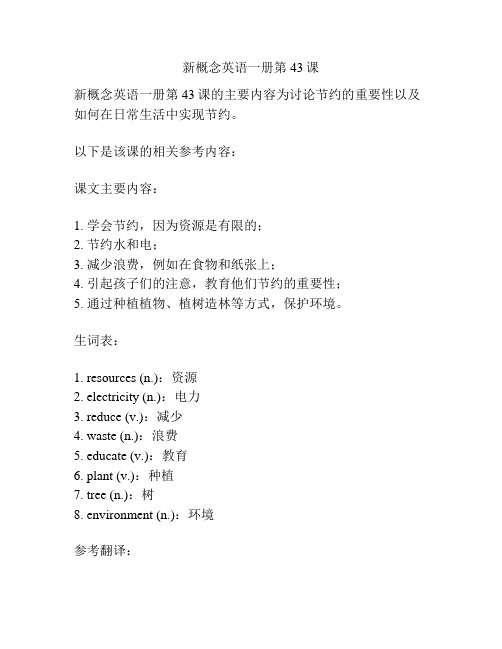
新概念英语一册第43课
新概念英语一册第43课的主要内容为讨论节约的重要性以及如何在日常生活中实现节约。
以下是该课的相关参考内容:
课文主要内容:
1. 学会节约,因为资源是有限的;
2. 节约水和电;
3. 减少浪费,例如在食物和纸张上;
4. 引起孩子们的注意,教育他们节约的重要性;
5. 通过种植植物、植树造林等方式,保护环境。
生词表:
1. resources (n.):资源
2. electricity (n.):电力
3. reduce (v.):减少
4. waste (n.):浪费
5. educate (v.):教育
6. plant (v.):种植
7. tree (n.):树
8. environment (n.):环境
参考翻译:
1. We must learn to economize because resources are limited.
2. We should conserve water and electricity.
3. We need to cut down on waste, such as food and paper.
4. We should draw children's attention to the importance of saving and teach them how to economize.
5. We can protect the environment by planting plants, trees and forestation, etc.。
新概念英语第一册43课
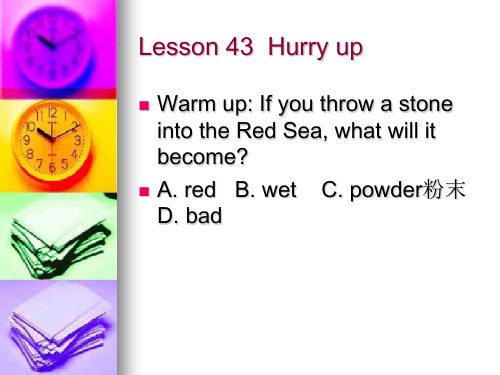
单词讲解
1.of course.当然 2.kettle:n. 水壶 electric kettle 电水壶 3.behind: prep. 在…后面 There is a chair behind the table. behind the times:过时的,落伍的 Tom’s cell phone is behind the times. 4.teapot: n. 茶壶. Pot锅、罐、容器 →火锅hot pot →花盆flower pot 5.now: adv.现在、此刻(常放句尾) I am cooking/studying now.
6.find: vt.找到、发现 look for: 寻找. Mary is __ the Police Station(警察局), but she can’t __ it. A. look for / find B. finding/ looking for C. looking for/ find D. see/look 7.boil: vi.沸腾 The kettle is boiling. vt.煮 Please boil me an egg. ↓Please boil an egg for me. oil: 油. 37课paint →油画?oil painting
Lesson 43 Hurry up
பைடு நூலகம்
Warm up: If you throw a stone into the Red Sea, what will it become? A. red B. wet C. powder粉末 D. bad
自然拼音1:
1. A: 梅花音/æ / bad, bag, apple, ax, actor, ant 2. B: /b/ bat, bed, box, bird, body, boy 3. C: /k/ cat, cap, car, coffee, cow, cake /s/ city, cell phone, cyber name 4. D: /d/ dad, desk, doctor, dog, duck 5. E: /e/ egg, end, elephant, elf, envelope 6. F: /f/ fat, four, foot, feet, five, family Cat, cat, catch that fat rat! 字母“oo”组合的发音:d\k之前发短/u/,其它 情况发长/u:/,脚与食物恰相反,food长 foot短.
新概念英语第一册Lesson43-44笔记(语法点+配套练习+答案)
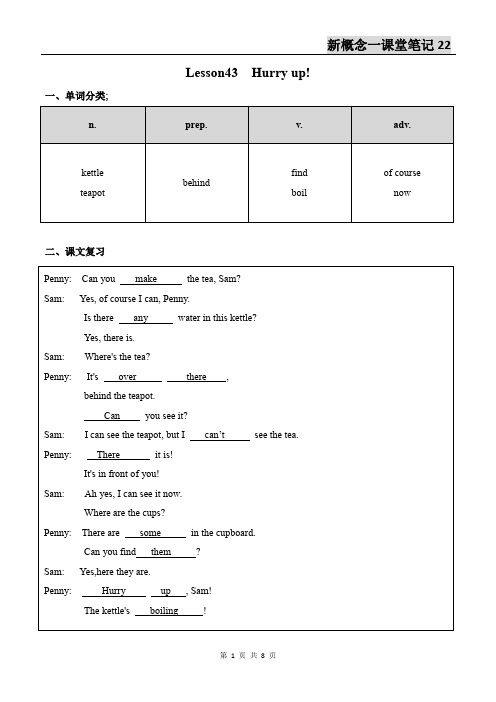
12.footfeet
13.toothteeth
14.sheepsheep
15.deerdeer
2.情态动词can
情态动词用来表达人的情感、态度,不能单独使用,
后跟动词原形,没有数和人称的变化
can的用法:
1.能,会,表能力
I cancookKungpao chicken well.
否定回答用:Sorry.
练习
1.N能力or Q请求?
1.He can cook.N
2.Can I play here?Q
3.Can you sing?N
4.What can you do?N
5.Can you sing for me?Q
6.Can I ask you a question?Q
7.What can I do for you?Q
答句:Yes, I can. / No, I can’t.
对划线部分提问:What can you do?
2.可以,表能力,常用于疑问句中
如:Can I ... ?或Can you ...( for me)?
Can I help you?我可以帮你吗?
Can you help me?你可以帮我吗?
肯定回答用:Sure. / Of course. / Certainly. / No problem. / OK.
Lesson43 Hurry up!
1、单词分类;
n.
prep.
v.
adv.
kettle
teapot
behind
find
boil
of course
now2、课文复习三 Nhomakorabea课文重点
新概念英语第一册43课课件

Mix up different learning activities to keep the learning process engaging and interesting, such as reading, listening, speaking, and writing exercises.
Recommended learning resources
Official course materials
Make use of the official course materials provided, which typically include textbooks, workbooks, and other resources designed to support your learning.
详细描述
名词性从句在句子中充当主语或宾语,具有名词的功能。它包括主语从句、宾 语从句和表语从句。例如,“What he said is not true.”中的“What he said”就是一个主语从句。
Adverbial clause
总结词
作为句子状语的从句
详细描述
状语从句在句子中充当状语,用来修饰动词、形容词或副词 。它可以表示时间、原因、条件、让步等关系。例如,“If you go to the party, you will have fun.”中的“If you go to the party”就是一个条件状语从句。
New Concept English Volume 1 Lesson 43 Courseware
目录 Contents
• Sorting out the content of the text • Grammar Focus Analysis • Textual elaboration and practice • Expand reading and listening skills • Suggested learning methods
新概念英语第一册43课课件.ppt
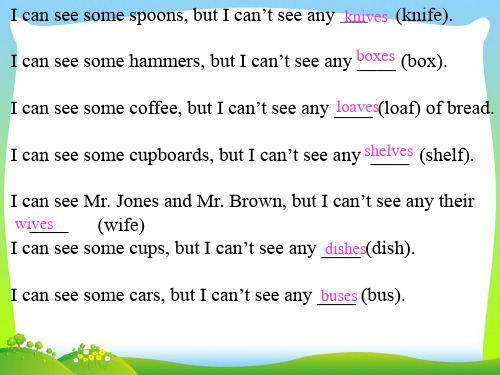
Can you make the tea, Sam?
1. can 是一个情态动词, 没有单,复数的变化,后面跟动词原 形.
2. can表示能,会的意思 3. can的否定形式can not=can’t
Can I help you?
A: Can you make a bookcase?
B: Yes, I can. No, I can’t
。2020年7月24日星期五2020/7/242020/7/242020/7/24
• •
THE END 15、会当凌绝顶,一览众山小。2020年7月2020/7/242020/7/242020/7/247/24/2020
Sentence patterns
Are there _a_n_y_ glasses on the table? Would you like some tea? There ares_o_m__e glasses on the table. There aren’t _a_n_y_ glasses on the table.
• 13、志不立,天下无可成之事。2020/7/242020/7/242020/7/242020/7/247/24/2020
• 14、Thank you very much for taking me with you on that splendid outing to London. It was the first time that I had seen the Tower or any of the other famous sights. If I'd gone alone, I couldn't have seen nearly as much, because I wouldn't have known my way about.
新概念第一册第43、44课PPT课件
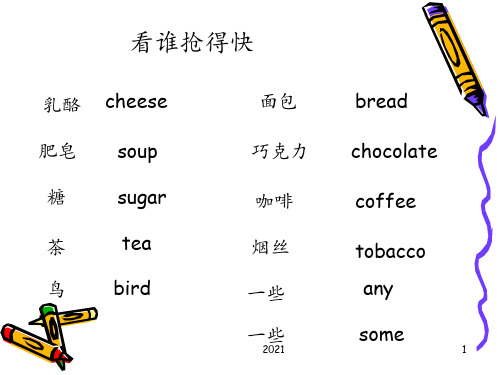
乳酪 cheese
肥皂 soup
糖
sugar
茶
tea
鸟 bird
面包
巧克力
咖啡 烟丝 一些 一些
2021
bread chocolate coffee tobacco
any some
1
What is this ?
2021
2
2021
3
of course [əv-'kɔːs] 当然
kettle ['ketl]
2021
14
-你能看见那个男孩吗? -是的,我能看见. -Can you see that boy? -Yes ,I can.
-你会煮咖啡吗? -是的,我会煮. -Can you make the coffee? -Yes ,I can.
2021
15
3.Is there any water in this kettle ? Yes ,there is .
make the coffee 煮咖啡
make the bed 整理床铺
make the bookcase 做书架
2021
11
2.Yes ,of course I can .
of course 当然(口气强硬)
Eg.当然了,这是我的新车。 Of course, this is my new car. 当然我是对的。 Of course I am right.
hammers/behind that box Are there any hammers hehind that box? Yes ,there are .There are some on the table.
2021
新概念英语第一册-Lesson-43 课件(共17张PPT)
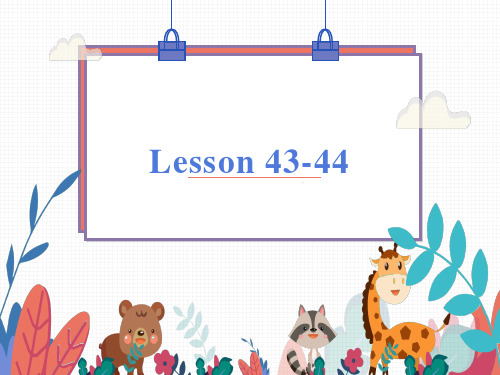
名师课件免费课件下载优秀公开课课 件新概 念英语 第一册- Lesson -43 课件(共17张PPT)
• PENNY: Can you find them?
• SAM: Yes. Here they are.
• PENNY: Hurry up, Sam.
•
The kettle’s boiling!
名师课件免费课件下载优秀公开课课 件新概 念英语 第一册- Lesson -43 课件(共17张PPT)
名师课件免费课件下载优秀公开课课 件新概 念英语 第一册- Lesson -43 课件(共17张PPT)
There be 句型 There be 句型表示某处有某物。 There is a/an + 可数名词单数 There is some + 不可数名词 e.g. There is some cheese on the plate.
名师课件免费课件下载优秀公开课课 件新概 念英语 第一册- Lesson -43 课件(共17张PPT)
soap tea 1/4磅茶 cheese chocolate milk coffee 半磅咖啡 sugar 一磅糖 bread tobacco 一听烟丝
名师课件免费课件下载优秀公开课课 件新概 念英语 第一册- Lesson -43 课件(共17张PPT)
The kettle’s boiling. 水开了。
名师课件免费课件下载优秀公开课课 件新概 念英语 第一册- Lesson -43 课件(共17张PPT)
名师课件免费课件下载优秀公开课课 件新概 念英语 第一册- Lesson -43 课件(共17张PPT)
译文
彭妮:你会沏茶吗,萨姆? 萨姆:茶壶我看见了,但茶叶没看到。
新概念英语第一册43课ppt课件
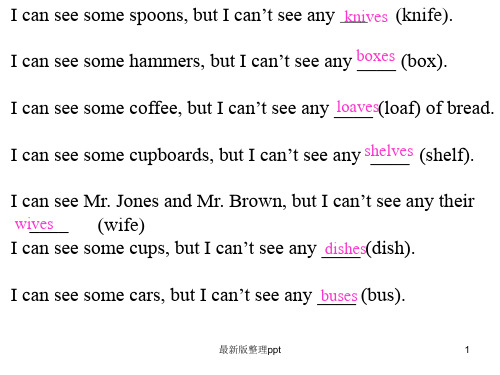
I can see some coffee, but I can’t see any _lo_a_v_es(loaf) of bread. I can see some cupboards, but I can’t see any s_he_l_ve_s (shelf).
boil
最新版整理ppt
13
teapot
make the 最新版整理ppt tea
14
Lesson 43 Hurry up!
Can Sam make the tea? How do you know Sam doesn’t make the tea very often?
He can’t find anything.
最新版整理ppt
15
Can you make the tea, Sam?
1. can 是一个情态动词, 没有单,复数的变化,后面跟动词原 形.
2. can表示能,会的意思 3. can的否定形式can not=can’t
Can I help you?
A: Can you make a bookcase?
Hurry up or we’ll be late.
The kettle’s boiling.
The water in the kettle is boiling.
最新版整理ppt
19
homework
一, 背书 ( L 43 ) 二, 听写 ( L 41 & 43 ) 三, 阅读 ( U 3 & 4 )
新概念英语一 Lesson43(共39张PPT)
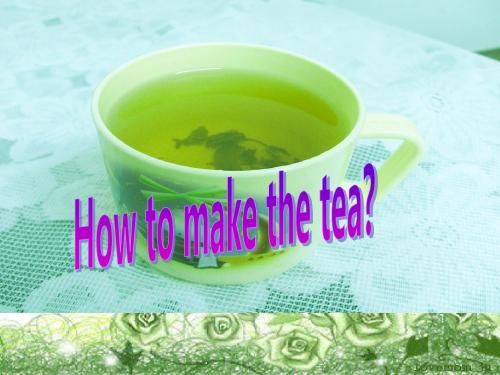
1.表示“能、会”,指脑力或体力方面的“能力”。 例如:I can speak Chinese.我会讲汉语。
2.表示“可能”,常用于否定句或疑问句中,指某种可能 性。
He can’t be in the classroom. 他不可能在教室里。
3.表示“可以”,常用于口语中,指许可或请求做某事。 Can I have a cup of tea, please?请问我可以喝一杯茶
-Yes, there is. / No, there isn’t. 肯定-否定回答
Is there a cup of tea on the desk? Yes, there is.
Are there two cups of tea on the desk? Yes, there are. Are there two cups of tea near the teapot? Is there any tea in the teapot?
Can you see it?
SAM: I can _____ the ______, but I can't see the ____.
PENNY:
There it is!
It's ______ ______ ____ _____!
SAM: Ah yes, I can see it now.
______ ____ _____ _____?
but 但是,连词,表转折。 can’t = can not = cannot 不能,不会。
There it is! 就在那儿! 倒装句,表强调。
Here it is! Here they are.
There are some (cups) in the cupboard.
新概念英语一 Lesson43(共39张PPT)
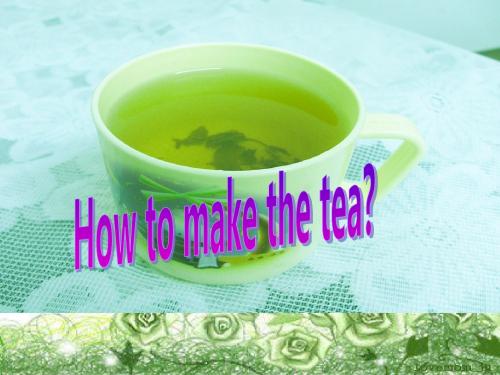
• • ③以f, fe 结尾的 变f或fe为v +es : • thief wife life knife wolf half leaf s
helf
• behind the times 落伍,赶不上时代
• after在……之后, 主要用于时间或次序; behind 主要用于位置。
• just now 刚才; • right now 立刻 • from now on 从今以后 • then adv. 那时 • 机不可失 now and never!
• 例如:Could you help me with my English? 你能帮助我学习英语吗?
情态动词can的基本句型: 1.肯定句型为:
主语+can+动词原形+其它。
They can play basketball. She can dance. You can go to watch TV.
• PENNY: • SAM: • • PENNY: • SAM: • PENNY: • • SAM: • PENNY: • • SAM: • • PENNY: • • SAM: • PENNY: •
Can you ____ ______ ______, Sam? Yes, _____ ______ I can, Penny. Is there any _____ in this ______? ______, ______ _______. _____ ______ _____? It's over there, _______ the teapot. Can you see it? I can _____ the ______, but I can't see the ____. There it is! It's ______ ______ ____ _____! Ah yes, I can see it now. ______ ____ _____ _____? There are some in the _______. Can you _____ them? Yes. Here they are. _______ _______, Sam! ______ _______ ________!
新概念第一册43-44PPT课件
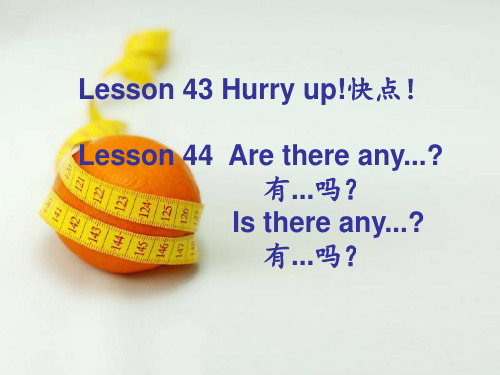
child—children fish---fish(fishes) deer—deer Chinese—Chinese Japanese---Japanese
.
4
Discuss
• How to make the tea? • What must I do at first?
tie vase cheese money dollar
suit soap bird
hammer
coffee
bread meat
air
photo
case fish chicken water glass
cup
.
2
Байду номын сангаас
不可数名词(uncountable nouns)
可数名词/不可数名词
可数名词的单复数变化:
• certainly 当然(口语和书面语) • sure 当然(美语多用)
★find 找到(表示结果)
• ① v. 找到;寻得
• It is most important to find a suitable person for the job.
• ② v. 找出;查明
• Shall we ever find an answer to the tough problem?
些用some修饰。
.
3
可数名词单数变复数:
1. 直接加s cat----cats 2. 以s. x. z. o. ch. sh 结尾加es.(特例kilo,photo,
hero这三个加s.) 3. 辅音加y结尾 把y改为i 再加es
新概念第一册43-44课ppt课件
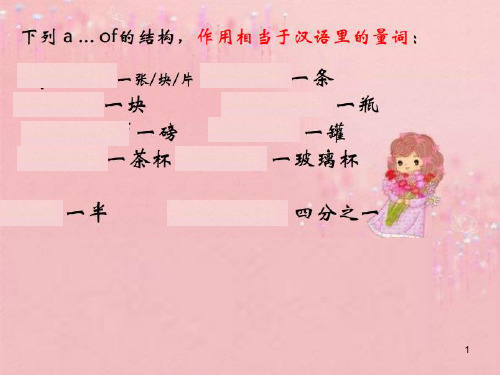
17
step1
put the kettle on the electric cooker
step2
wait ten minutes
step3
The kettle is boiling!
18
step4
put the tea into the teapot
pour (倒) the water into the teapot
the day after tomorrow 十点之后
after ten o'clock 星期一之后我可以把照片给你看。(show) I can show my photos to you after Monday.
7
It’s ______ the teapot.
A. behind
B. after
12
煮
水开了。 The water is boiling. =The kettle is boiling. 煮鸡蛋 boil eggs 他正在干嘛? What is he doing? 他正在煮鸡蛋。 He’s boiling eggs.
13
14
绿茶 红茶
15
Lesson43 Hurry up
Is there any…?
2
New words and expressions
of course 当然 kettle 水壶 behind在..后面 teapot 茶壶 now 现在此刻 find 找到 boil 沸腾,开 can 能够
3
4
那是你的老师吗? 当然是。 你能给我一杯咖啡吗? 当然。 这是你的汽车吗? 当然不是,那是我的小汽车。
她正站在公园的大门前。(park gate) She is standing in front of the park
新概念英语第一册43课精品
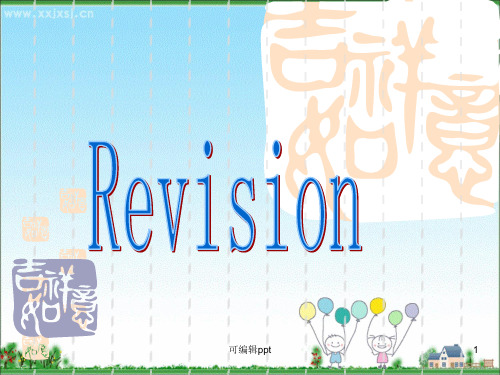
可编辑ppt
46
Hurry up! 快点
Hurry B ! You are late. A at B up C in
可编辑ppt
47
Sum up
可编辑ppt
48
New words and expressions
1 /of co-urse 2 /kettl/e 3 / b/ehind 4 / teapot/
可编辑ppt
32
Hurry up,Sam!
可编辑ppt
33
可编辑ppt
34
1 Can you make the tea , Sam? (P1) Yes, of course I can. (P1) Can you see it? (P4) I can see the teapot. (P4) I can’t see the tea. (P4) I can see it now. (P5) Can you find them? (P7)
Are there any cars on the bridge?
可编辑ppt
3
Can you make the tea?
- 1、下载文档前请自行甄别文档内容的完整性,平台不提供额外的编辑、内容补充、找答案等附加服务。
- 2、"仅部分预览"的文档,不可在线预览部分如存在完整性等问题,可反馈申请退款(可完整预览的文档不适用该条件!)。
- 3、如文档侵犯您的权益,请联系客服反馈,我们会尽快为您处理(人工客服工作时间:9:00-18:30)。
Can he see the cups ?
Yes, he can. / No, he can’t.
总结: 情态动词 must may should 他们的否定都一 样加not, 变疑问把情态动词提前就可以。
请翻译下列句子:
1.我能打开收音机。 turn on find 2.他能找到他们。 3.我的小弟弟能喝茶。 drink tea paint 4.Tom能涂色。 5.你会努力工作? work hard climb the tree 6.你妈妈会爬树? walk 7.宝宝不会走路。 cook 8.我爸爸不会做饭。 9.我不会洗盘子。 wash the dishes 10.狗不会游泳。 swim
bread\ on the table Is there any bread on the table? Yes, there is. There is some on the table.
7. cups\ in front of that kettle 8. cars\ in front of that building 9. newspapers\ behind that vase 10. hammers\ behind that box 11. teapots\ in the cupboard 12. rice\ in the bowl
挑战
Is there any water in this kettle?
• There is some water in this kettle. • There is not any water in this kettle. • Is there any water in this kettle? • Yes, there is./ No, there isn’t.
Lesson 43
Hurry up!
Can you make the tea?
Discuss
• How to make the tea? • What must I do at first?
Step 1 Before making the tea
kettle
tea
teapot
tea cups
操练 There be 的一般疑问句
1. milk\ in front of the door 2. soap\ on the cupboard 3. water\ in those glasses 4. tea\ in those cups 5. coffee\ on the table 6. chocolate\ behind that book
Hurry up!
New words
• of course
• `ket-tle • behind • teapot
n. prep. n.
• now
• find • boil
adv.
v. v.
Questions:
• 1. Is there any water in the kettle? • 2. Where’s the tea? • 3. Can Sam see the teapot? • 4. Can Sam see the tea? • 5. Where are the cups? • 6. Sam often makes the tea, yes?
可数名词单数变复数:
1. 直接加s cat----cats 2. 以s. x. z. o. ch. sh 结尾加es.(特例kilo,photo, hero 这三个加s.) 3. 辅音加y结尾 把y改为i 再加es factory—facotories. 4. f fe结尾把f fe改为v再加es. knife—knives half—halves wolf—wolves. 5. 其它特殊记:man—men woman—women child—children fish---fish(fishes) deer—deer Chinese—Chinese Japanese---Japanese
不可数名词(uncountable nouns)
可数名词/不可数名词 可数名词的单复数变化: deer sheep 不变 不可数名词做主语,谓语用单数形式。 1)The water is hot. 2) The air smells sweet. 不可数名词用量词表示数量(Lesson41): 多于2时,量词变复数---two pounds of tobacco 很多用much,a lot of,一点点用a little,一 些用some修饰。
There are some in the cupboard.
• There are some cups in the cupboard. • There are not any cups in the cupboard. • Are there any cups in the cupboard? • Yes, there are./ No, there aren’t.
How to make the tea?
Can Sam make the tea?
Of course!
Over there!
Can see... Can’t see...
There it is! in front of
Where are the cups?
cupboard find
Here they are!
Step 6 Fill up the teapot
Fill up the pot with boiling water Wait for a little while again
OK!
a. Before making the tea b. Boil the water c. Shower them d. Put tea into it e. Washing the tea f. Fill up the teapot
Step 2 Boil the water
Don’t over-boil it!
Step 3 Shower them
Step 4 Put tea into it
fill half of the teapot with tea leaves
Step 5 Washing the tea
• Pour boiled water into the pot • Wait a minute • Pour the water out of the pot
情态动词用法:can 结构:主+can +动词原形+其它
• I can make the tea.
否:I can not make the tea. He can see the cups. He can not see the cups.
问:Can you can’t.
Revision(复习)
请找出下面单词中的不可数名词
(uncountable nouns):
tea teapot passport milk spoon tie vase cheese money suit soap bird bread meat hammer coffee air photograph case fish chicken water glass cup
